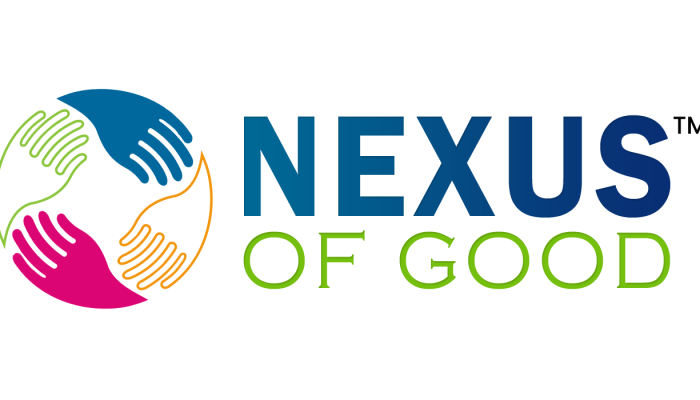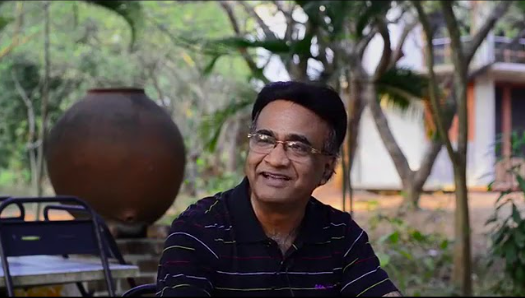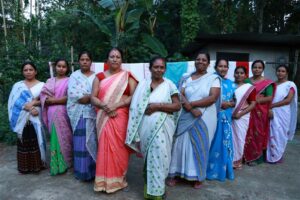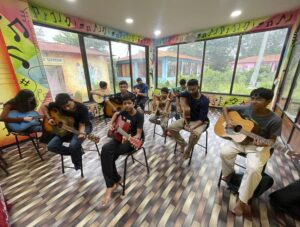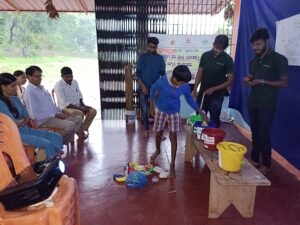Trifed: 2017-2021
Spectacular, Revolutionary!
At a time when the economy globally is reeling under an unprecedented pandemic, a spirited bureaucrat with right political guidance and support gears up and steers Trifed, a little-known Federation, to break new grounds and achieve many times more than what it had achieved in its first three decades!
How would you describe it if, in a span of five years (2017-2021), two of which were marred by the pandemic, an organization presses forward and successfully organizes thirty-three tribal cultural festivals, with exhibition-cum-sales of tribal handicrafts, involving 5930 artisans, to generate a cash-flow of Rs.244.79 million to their homes? During the same period, its showrooms across the country tripled from 43 (that had been set up over a period of thirty years) to 120; sale-proceeds vaulted a whopping 227.11% from Rs.123.2 million to Rs.403.0 million! Procurement of tribal handicrafts rocketed 575.42% from Rs.76.5 million to Rs.516.7 million! Artisan man-days boosted nearly seven-fold from 0.244 million to 1.654 million! All this just in one – handicrafts – division. Add to that the performance in the Non-timber Forest Products (NTFP) division: procurement up 6043% from Rs.30 Cr to over Rs.1843 Cr! Procurement extended from just 9 States to 27 States, to stamp a pan-India presence, thereby reaching out to over 25 lac tribal families, organized into over 37,900 groups! Establishing over 6800 processing units for NTFP, to secure round-the-year employment for 6.77 lac tribal forest gatherers! Conceptualizing and establishing a food-park dedicated to NTFP in tribal Bastar.
How would you describe that? Spectacular? And yet, that is not the full story! Call it just a synoptic trailer!
Trifed was created in 1987 to drive tribal development through marketing support for tribal products. The object was noble and clear, but the strategy to realize that object, remained unclear. The result of this was that the organization kept groping for a right course, limping now this way, now that. Three decades passed thus!
Every organization has its own date with destiny! Trifed’s transformation began in 2017 when a new Managing Director, Pravir Krishna, who had earlier earned wide attention for his work as Collector in tribal Bastar, took charge of the slumbering organization. This Secretary-level officer of the Indian Administrative Service opted for this post, which otherwise was scorned in his circle as a ‘loop-line’. He came with ideas that perhaps sounded too revolutionary (read crazy) in urbane bureaucratic chambers. He faced doubting Thomases at every step. But his never-say-die zeal prevailed over their cynicism. When Arjun Munda, former Chief Minister of Jharkhand, a predominantly tribal State, was made the Minister for Tribal Affairs, political will and push followed, to add momentum to his work. Soon a formidable team formed under the Minister, his two deputies, and the Secretary, Ministry of Tribal Affairs. Five years down the line, the numbers and action speak for themselves.
Trifed works in two broad fields. The first relates to direct, retail marketing of tribal handicrafts sourced from the artisans empanelled through a defined process. The second, and more important field, relates to providing the tribes an equitable deal in the trade of non-timber forest produces (NTFP). This second field is thornier, because it is replete with deeply-entrenched foul trade practices at all levels. The stakes involved in NTFP are far larger than that of handicrafts, because the volumes of NTFP in terms of both, quantity and value, is colossal. This has resulted in vested interests at all levels, who operate silently, ‘drinking ghee under a blanket’, as the Hindi proverb goes. Most administrators are either simply unaware of the intricacies involved in this field, or they simply shy away from putting their hands in a hornet’s nest. Having seen first-hand the subtle (but predatory) exploitation of the tribes in Bastar, Pravir Krishna had the benefit of an insider’s perspective in the matter. Trifed, he believed, was a right platform to make a dent. Arjun Munda and his deputies brought in first-hand experience of matters in tribal markets. Their guidance, support and inputs proved invaluable. The object was clear, yet, to realize it on the field, the challenge was daunting. Nonetheless, he chose to give it his best try. He made a mission of it in the last phase of his career, to toil, and inspire others to toil, almost 24 x 7, to create a model and demonstrate how trade can be a most effective engine to drive tribal development! The results are enough to drop any listener’s jaws!
But let’s complete the handicrafts story first.
Increasing the retail outlets for handicrafts, called TribesIndia, from 43 to 120 across India is one thing. To ensure strategic location of the new outlets in major airports and heritage-buildings where tourist footfalls are high, poses a much bigger challenge and a load of work for coordination with multiple ministries and agencies. This might easily have dampened the spirit of lesser mortals.
Retailing tribal handicrafts is not like retailing rice or salt. It is a very different ball-game. The focus therefore was shifted to total-consumer satisfaction through an immersion in the tribal world. How? Handicraft sales were (are) clubbed with ethno-cultural festivals, called Aadi Mahotsavs, incorporating tribal dance, song and ethnic food. This transformed shopping to a brief immersion in another, esoterically exciting world. It boosted the sales of handicrafts.
Many among us love tribal handicrafts, and often talk glibly about sustaining and promoting this dying genre, but do we care to probe why it is dying, and where lies the remedy?
Senior officials in the Ministry of Tribal Affairs, and Trifed did some brainstorming. It did not need much research to understand the causes: dwindling interest-level of the artisans, caused by low work-days, compounded by unremunerative returns. In the absence of effective State intervention, unscrupulous operatives, hungry for usurious margins, seemed bent on butchering the goose that gave them the golden eggs. The goose (tribal artisan) therefore felt it better to shy away from handicrafts and, instead, opt for wage-labour under MNREGA! Pravir Krishna, chose to focus on Trifed’s principal objective, namely, to profit the artisan. He got Trifed to recalibrate its pricing structure to ensure that the artisan received the lion’s share in the sales revenue. This proved like infusing fresh blood into the artisans’ veins! They began to receive more work-orders and better margin! This resulted in a trade-wapsi for those tribesmen who had deserted handicrafts. Trifed’s supplier-base expanded.
For the strategically located new outlets with high footfalls, convergences have been forged with bodies like LIC, ASI, AAI, Ministry of Petroleum and Natural Gas, Department of Posts, Ministry of Culture, and LBSNAA, Mussoorie. Five years ago, if you mentioned Tribes India, ninety-nine out of a hundred persons would ask, Sorry, what? Today, Tribes India is fast emerging as the go-to place for buying authentic tribal products, from showrooms or online. The mantra for success is: quality products in a wide range, fair prices, outlet expansion plus e-shopping, and targeted publicity. In FY 2020-21 alone, 1709 products were sourced from tribal artisans.
It was felt that the idea of tribal in handicrafts was getting cliched, with just a handful of tribes and their handful of products represented in a showroom. To give an equitable representation to all tribes in India, a benchmark of 1200 artisan-suppliers from each of the fourteen administrative regions of Trifed has been set.
A bottleneck adversely affecting sales of tribal handicrafts relates to safe and handy packing. To crack this, Trifed has hired the services of professional agencies. Better and safer packing is boosting sales and revenue.
Just when things were feeling like a sweet-dream, the killer Covid struck! It threatened to kill cottage-level commerce and industry more than lives, perhaps. Shutters were downed on the urban show-rooms. Even when they opened, footfalls dropped to near zero. Trifed rose to the challenge. It not only provided cash relief to the artisans during lockdown, but also entered the no-contact e-market. Apart from tie-up with e-tailer giants like Amazon, Trifed has set up its own portal so buyers can shop from the ease of their homes.
During a pandemic and thereafter, handicrafts are not topmost on anybody’s shopping list. Nonetheless, in these testing times, Trifed has set up 6930 Stock Keeping Units (SKUs) and achieved a sale of Rs.131.76 L through the fledgling e-counters!
Team Trifed is aware that Trifed is not meant to grow into a trading house, but rather be a facilitator and promoter of trade in tribal products. He is therefore focussing on the franchise model for new outlets. This approach means a win-win situation for both, the tribal artisans as also the urban youth exploring new business prospects. Retailing of tribal products offers such youth an opportunity to combine commerce with social service.
II
If Trifed’s performance in the last five years has been spectacular in the field of handicrafts, in the other field of non-timber forest produces (NTFP) it has been revolutionary.
The scheme of minimum support price (MSP) for non-timber forest produces (NTFP), also called minor forest produces (MFP), was launched in 2013-14. It had a sub-moderate impact. The number of produces included were very few; the price-fixation mechanism was complex and unrealistic. The scheme was launched in very few States. The entire approach seemed overly defensive.
In 2017, Pravir Krishna persuaded the Ministry of Tribal Affairs to re-build the scheme. The coverage of the scheme was expanded in terms of both, NTFPs and also the States covered. An MOU between Trifed and the States was introduced to lend greater clarity and discipline to the scheme. Pravir Krishna and his officers travelled to every State to sensitize leaders and officers regarding the importance of the scheme for their State. The Minister spoke with the Chief Ministers. The Secretary, Tribal Affairs, wrote to the Chief Secretaries of States. The result: From just 9 States in 2013, today 28 States are covered; from just ten produces in 2013, today nearly fifty produces are included; the tribal NTFP-gatherers (almost entirely women) have increased tenfold! The mechanism to determine MSP has been rationalized. Procurement has shot up from Rs.30 Cr (2013) to Rs.1843 Cr! The changed strategy has resulted in an estimated aggregate benefit (State procurement + private sector procurement at MSP) of more than Rs.3,841 Cr – a figure that was unimaginable five years ago!
All this is spectacular, true, but how is it revolutionary?
The true achievement of Trifed goes far beyond numbers. It concerns a new perspective on MSP for MFP, enough to make economists sit up and think anew. Traditionally, MSP has been seen as a ‘safety net’ set up by the State to help the vulnerable farmer against market forces he does business with. MSP therefore was seen to be ‘market-price-minus-x’. This maybe the right approach as regards the farm sector, which has generally been under better watchful eyes. MFP, which by its very definition is viewed as ‘minor’, belongs to the tribal world and the remote backwaters of economy. It represents a ‘neglected sector’ in a very literal sense. The market dynamics in the tribal haat bazar have been predatory. To adopt the ‘market-price-minus-x’ formula for fixing MSP for NTFP, in a context where the market price is the middleman’s call and exploitatively low, would mean nothing. Worse. Such an MSP would lend a legitimacy to the middleman’s price-call and be tantamount to giving a clean chit to the unfair trade practices.
Under Trifed’s proactive approach to ensure a fair deal for the tribes in the trade of NTFP, MSP determination mechanism has been rationalized and turned on its head. Instead of being a passive ‘safety net’, MSP for MFP has been made into a tool for ‘coercing’ fair prices. The price is now scientifically determined by an experts committee, taking into consideration various factors. Instead of trailing the market price for produces, the MSP now leads the market price. Why? Because under the middleman’s call, as the AG’s audit observed, the NTFP gatherer was getting just around twenty percent of the end-price; the labour she invested did not get her even half of what it deserved as per the notion of minimum wage. Sweat equity and owner’s royalty on NTFP was a far cry. An aggressive approach was necessary to break the unfair practice. By leading the market price, Trifed has been able to achieve what was never achieved before: namely, constraining the middlemen to pay fair prices to the tribal gatherer, or face extinction in the market. This strategy has worked! The tribes have gained an aggregate of more than Rs.3,841 Cr in FY 2020-21!
A bane of NTFP business as regards the tribes-woman who gathers it from the forest, is that she is constrained to sell it in raw form. Value addition can fetch her far better returns, and also ensure gainful work beyond the NTFP season (usually four months a year), but that requires facilities, training and restructuring of the trade. Trifed picked the gauntlet. A new scheme named Van Dhan (meaning, ‘wealth of the forest’) was launched in 2018. This focusses on strengthening of infrastructure to facilitate processing for value addition. The forest-gatherers have been organized into groups of twenty each. The group is called Van Dhan Vikas Kendra (VDVK). Around 15 VDVKs are clustered together into a VDVK Cluster (VDVKC). 6.77 lac NTFP gatherers in 253 districts in 25 States and UTs are involved through an MOU of the State with Trifed. In terms of the MOU, 37,904 VDVKs have been established, and clustered into 2275 VDVKCs. The State Nodal Agencies receive working capital for NTFP procurement, grants for strengthening facilities in the haat bazar (poor or no facilities cause damage to the produce due to rain, mud-contact etc). Grants are also given for construction of a common facility centre for the VDVKC, for the members to sit and process the produce. Rs.336.95 Cr have been sanctioned to date. Several VDVKCs have installed plant and machinery for tertiary processing, packaging and branding of the produces. These include jams, jellies, candies, pickles, honey, tamarind products, hill-grass brooms, cashew, healthcare products, and a number of processed spices. The produces are marketed through Trifed’s nearly 150 outlets. The VDVKs are free to market the produces through other channels also.
The law has conferred ownership status on the tribes in respect of the local NTFP. Trifed is aggressively inspiring the tribes to use this right to manufacture finished products. The idea is to move beyond the traditional mind-set of viewing tribes-folk as wage-labour. The new aspiration is to transform them into entrepreneurs. The battle-cry now is: mera van, mera dhan, mera udhyam (‘my forest, my wealth, my industry’). To push the idea further, terms like ‘start-up’ are being popularized in tribal parlance. This is working wonders. Some tribal VDVKCs, for example, have, on their own, ventured into FMCG sector and started making shaving foam, cold-cream, sanitary pads, sunscreen, herbal hair-dye, green tea, rakhis, herbal Holi-colours and what not. Because Trifed stepped up its work during the pandemic, the tribal start-up units ventured into new-demand product-lines: face masks, liquid-soap in dispensers, disinfectants and bathroom cleaners! The Goliath apparently has woken from his slumber. The flame of a revolution has been lit. Trade guilds have begun to take note of this. Trifed won seven awards at the ET Business Awards 2020!
Trifed and the tribes seem to be inspiring each other. Seeing the tribes’ new-found enthusiasm for processing of NTFP, Trifed has scaled up the idea under a scheme called Trifood. This relates to establishment of NTFP-based food parks in tribal areas. Two such parks are fast taking shape in Jagdalpur (Chhattisgarh) and Raigad (Maharashtra). These are being set up in collaboration with the Ministry of Food Processing. Many more Trifood parks are in the pipeline. Trifed’s meteoric achievements owe in a large measure to its approach of convergence with the relevant schemes of other Ministries. This is just what the Hon’ble Prime Minister had proposed when he advised all departments and ministries to give up the culture of operating in silos, and to mutually synergize. Trifed has forged arrangements and tied up with a number of ministries and bodies. These include, tie-up with MSME under their SFURTI scheme and ESDP program for skill development; MoFPI for Mini-Trifood projects under the PM-FME scheme; MoRD, for infrastructure development for MSP for MFP scheme; MoA and AYUSH for developing honey treatment units and 100 tribal NTFP companies; Niti Aayog for promoting livelihoods in aspirational districts through Van Dhan. While launching the Aspirational Districts program in 2017 in Bijapur district in Chhattisgarh, the Hon’ble PM had prophesized that Van Dhan has the potential of growing into a game changer in tribal-forest districts. This is coming true.
No talk of tribes in India can ever be complete without including our North-eastern States. Trifed has tied up with MoDoNER, to ensure special focus on the NER. This collaboration is in the form of Rs.150 Cr scheme for two years is called, Marketing and Logistics Development for promoting Tribal Products from North-Eastern Region. The scheme includes Geographical Indexing (GI) tagging of tribal products from NER. 30 such products have already been tagged. TRIFED aims at a cumulative turnover value of about Rs.186 Cr from the North-Eastern States in two years’ time.
GI is a concept around which global commerce shall revolve in the near future. Sadly, not many are aware about this. Tribal areas and tribal products are vulnerable in this regard. To raise awareness among future administrators of India, Trifed and LBSNAA tied up to organize a GI Mahotsav in March and June 2021 to sensitize the IAS probationers on GI, with special emphasis on tribal produces. Trifed proposes to register more than 500 of its empanelled artisans as Authorized Users (AUs) for their GI tagged products.
For both, administering e-commerce, and efficient internal house-keeping, Trifed has tapped technology in consonance with the ideas of Digital India. This includes developing a Digital Directory, tabulating the data of artisans, suppliers etc.
The Hon’ble PM’s call is for going vocal about local. Trifed has followed this utterly. In fact, Trifed is now going global for local. As a first, small but very significant step in this direction, an exhibition-cum-sales of herbal wellness products from the tribal world was organized by Trifed in collaboration with the MEA at the Indian Embassy in New York on the International Yoga Day, 2021. As the Embassy reported, the response was overwhelming. Similar showcasing programs are proposed in other countries too. This will open the world market for the products of the Van Dhan Start-ups.
All these in five short years, two of them marred by Covid!
The tribes of India are now on a great springboard. Pravir Krishna’s work in Bastar two decades ago, had shown that NTFP can be an amazing driver of tribal development, not only in terms of higher income, but also (maybe more so) in the fields of education, healthcare and holistic development. He has set the ball rolling now at the national level. The ball cannot but roll on.
